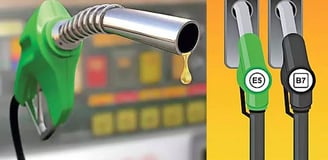Add your promotional text...
India's Ethanol Blending Milestone: A Pathway to Sustainable Energy and Economic Growth
Synopsis: India's Ethanol Blended Petrol (EBP) Programme has achieved significant progress in the 2023-24 supply year, with ethanol blending surpassing 13%—a record high. This blog explores the rapid growth of ethanol blending in India, the government's strategic initiatives, and the broader impact on energy security, environmental sustainability, and economic development. As India advances toward its goal of 20% ethanol blending by 2025-26, the EBP Programme stands as a critical driver of the country's future energy landscape.
MARKETSINDIA
By Sameer Malhotra
8/9/20243 min read


The Ethanol Blended Petrol (EBP) Programme in India has marked significant achievements in the current supply year (2023-24). With a remarkable increase in ethanol blending, the country has crossed the 13% threshold, surpassing the previous year’s figure of 12.06%. This growth reflects a major milestone, with ethanol blending surpassing 500 crore litres, as announced by the Minister of State for Petroleum and Natural Gas, Suresh Gopi, in the Lok Sabha.
Expanding Ethanol Blending Efforts
Government-owned Oil Marketing Companies (OMCs), including Indian Oil Corporation, Bharat Petroleum Corporation, and Hindustan Petroleum Corporation, have proactively participated in this initiative. These companies have invited bids for supplying an additional 66 crore litres of ethanol for the 2023-2024 supply year, covering the period from November 1, 2023, to October 31, 2024. This strategic move underscores the government's commitment to boosting ethanol blending as a key component of its energy policy.
Growth of the Ethanol Blended Petrol Programme
The Ethanol Blended Petrol Programme has seen exponential growth over the years. Starting from 38 crore litres in the Ethanol Supply Year (ESY) 2013-14, ethanol blending increased to 302.3 crore litres by ESY 2020-21. This impressive growth in ethanol blending percentages, from a modest 1.53% to 8.17%, highlights the success of the program in reducing India’s dependence on imported fossil fuels.
Rising Petrol Consumption and Ethanol Production
The period from ESY 2013-14 to ESY 2020-21 witnessed not only an increase in ethanol blending but also a substantial rise in petrol consumption, which grew by approximately 64%. This growth in demand for petrol further emphasizes the significance of the EBP Programme in meeting the country’s energy needs while also contributing to a cleaner environment.
Fuel-grade ethanol production has seen a dramatic increase, rising more than sevenfold from ESY 2013-14 to ESY 2020-21. This surge in production is a testament to the government’s efforts to encourage ethanol production through various initiatives, including interest subvention schemes aimed at enhancing and augmenting ethanol production capacity across the country.
Advancing the Ethanol Blending Target
In recognition of the successes achieved so far, the government has set an ambitious goal to advance the target of 20% ethanol blending in petrol from 2030 to ESY 2025-26. This forward-looking decision is poised to further accelerate the growth of ethanol production and blending in India, driving the nation towards energy self-sufficiency and sustainability.
National Policy on Biofuels and Feedstock Diversity
The National Policy on Biofuels-2018, amended in 2022, plays a crucial role in supporting the ethanol blending initiative. The policy has identified a wide range of feedstock for ethanol production, ensuring a diversified and sustainable supply chain. These feedstocks include heavy molasses, sugarcane juice, sugar, sugar syrup, and biomass such as grasses and agricultural residues like rice straw, cotton stalks, and corn cobs.
Additionally, sugar-containing materials like sugar beet and sweet sorghum, as well as starch-containing materials such as corn, cassava, and rotten potatoes, have been recognized as viable feedstocks. The policy also includes the use of industrial waste, off-gases, algal cultivation, and seaweeds, further broadening the scope for ethanol production.
In conclusion, India’s Ethanol Blended Petrol Programme stands as a shining example of how strategic government initiatives can drive substantial progress in the energy sector. The significant increase in ethanol blending, coupled with the expansion of production capacity and the identification of diverse feedstocks, positions India on a path toward achieving its energy goals. As the nation moves towards the ambitious target of 20% ethanol blending by 2025-26, the EBP Programme is set to play a pivotal role in reducing India’s carbon footprint and enhancing its energy security.
This progress not only benefits the environment but also supports the agricultural sector by providing a sustainable market for various feedstocks, thus contributing to the overall economic development of the country.
